Proposed $5B Norwegian Gas Export Pipeline Could Ease Europe's LNG Dependency

A new report by Wood Mackenzie, a global insight business for renewables, energy, and natural resources, suggests that a proposed $5 billion export route linking gas fields in the Barents Sea in Northern Norway to European markets could potentially alleviate the continent's reliance on liquefied natural gas (LNG) imports.
The report titled "Can the Norwegian Barents Sea help solve Europe's gas crisis?" highlights the resurgence of interest in the Barents Sea gas export route following Russia's invasion of Ukraine but also emphasizes the challenges that must be overcome before receiving approval from Oslo.
According to Daniel Rogers, Senior Analyst at Wood Mackenzie, the Barents Sea basin possesses abundant existing resources to fill the pipeline. However, the costs associated with developing the gas are higher than alternative imports from new LNG projects.
Despite this, the report emphasizes the cleaner nature of gas from the Barents Sea and underscores that any potential development would adhere to rigorous Norwegian environmental regulations.
To enhance cost competitiveness, the report suggests that state funding for the pipeline or the implementation of a Carbon Border Adjustment Mechanism, a tool devised by the European Union (EU) to incentivize cleaner industrial production in non-EU countries, could be considered.
"The carbon and socioeconomic argument for a pipeline - and further development of the basin - is strong, but it won't happen without government support. However, if long-term European gas demand and prices decline more rapidly than anticipated, it could further challenge the project's viability," Rogers stated, emphasizing the need for government support.
The report also cautions that while Barents Sea gas would help mitigate the decline in Norwegian production, it would not be a transformative solution. As such, a larger pipeline would be necessary to unlock the basin's potential and encourage high-impact exploration fully.
Presently, gas production in the Barents Sea primarily originates from the Snøhvit Area subsea fields, which are then transported via pipeline to the Hammerfest LNG facility. The facility is expected to operate at maximum capacity until the 2040s.
However, no direct pipeline connection exists between Barents Sea gas resources and the main Norwegian pipeline network.
